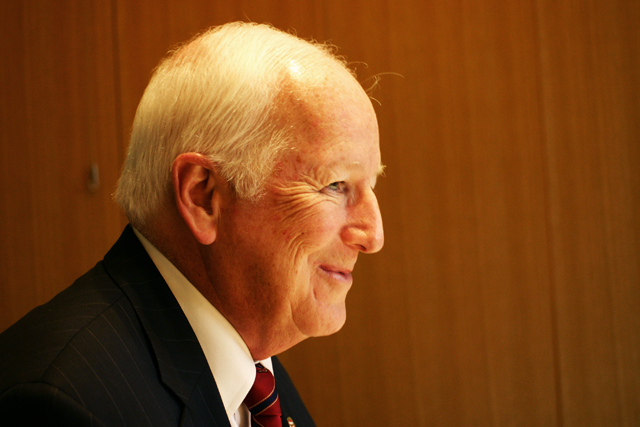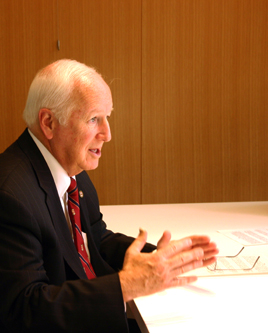Frontrunners of Medical Innovation III
Oct. 22, 2012

Yamano Today, we have three specific questions about biomedical innovation: research, personalized medicine and collaboration with the University of Tokyo. The first is about biomedical research in the US, especially in Washington University in St. Louis. What areas are most featured in promoting biomedical innovation in your university?
Prof. Shapiro At Washington University, we have a very broad research portfolio, and so, there are many areas that are interested in important opportunities for innovation. There are two areas where I think Washington University is very strong. It has a history of innovation, and these are the areas that we are trying to capitalize on and take advantage of. The first of these is in the area of biomedical imaging. We have a long history of activity in imaging. The first PET scanner in the world was built at Washington University, and today, we operate three cyclotrons on the campus to produce isotopes to support our research activities.
There are lots of new imaging areas that are under development and we are working on these in collaboration with a number of commercial partners and are trying to develop new ways to image everything from molecules to people.
The second area that we have focused on is in the area of genomics, as it applies to medicine and the aspiration to enhance personalized medicine and personalized approaches to medicine. Again, we have a long history in this area and Washington University has one of the largest genome sequencing institutes in the world, and during the time when there was an international collaboration to sequence the first human genome, Washington University contributed approximately 25% to 30% of the entire world’s effort in genome sequencing. But now, we are trying to take that information and make it applicable to human medicine and to improving healthcare.
Initially we are focusing on cancer because we think there are the greatest opportunities there. And as you may know, almost all human cancers are the result of changes in the genetic program of cells in our body that occur after birth. We are now able, technically, to complete the entire sequence of the genome of normal tissue and of cancer tissues from the same patient, and then to compare these sequences and try to identify those changes that have occurred in the cancer cells that make the cancer cell abnormal; and then also to use that information to select the very best treatment for patients.
This is turning out to be quite complicated because the amount of information that is generated by these kinds of studies is enormous, and having the data centers and the data handling capacity to make sense out of all of these information is turning out to be a big challenge, but one that is, I think, very promising.
One thing that would be an example of this involves a patient that recently - this episode was covered in an article in the New York Times but it involves a patient at Washington University who had a form of leukemia, a blood cancer, and had had multiple treatments which worked for a short period of time but then didn’t persist. We, over a year ago now, sequenced the genome of this patient’s cancer and his normal cells, and found the change in the cancer cells that was unexpected. It had never been associated before with leukemia. But that particular abnormality or mutation had previously been identified in patients who have a kind of kidney cancer. And one of the US drug companies, Pfizer, had already developed a drug that could work for kidney cancer patients who had that kind of mutation.

So we administered that drug to the leukemia patient, and his leukemia went into remission. And at this point now, 15 or 16 months later, he still remains in remission. So, we are very excited about this because there would have never been an idea to try this particular drug in patient with leukemia. And it’s just one example of the way that we hope we can expand the use of some of the current drugs that are available, and also develop clues and insights into new drugs that need to be developed for certain kinds of cancer.
Also recently in the New York Times was an article talking about a research of Washington University on breast cancer. And here, too, the scientists were able to separate, based on genomic studies, breast cancer patients into four different types, and each type responds to a different kind of chemotherapy or a different kind of treatment. And you would have no way of knowing that ahead of time without doing these tests. So we are very hopeful that this will lead to an era of personalized medicine that will extend beyond cancer to other diseases also.
Dr. Sato It sounds great that you can find more precise diagnostics and more effective medicines for each patient, and provide efficient medical care including disease prevention with patients.
Shapiro Yes. One issue that we are all concerned about, of course, is the cost of healthcare and medical care. Today, again using cancer as an example, there are some drugs that have been developed that are very effective in a small fraction of patients. And some of these drugs are very expensive. The cost of treating a patient for a year could be $50,000 US or more. And yet, these drugs, while very effective in some patients, only work in perhaps 10 of 15% of patients.
And so, if you have no way of telling which group of patients would respond, then the only choice would be to try these very expensive drugs in many patients and most often with no benefit.
Now, we hope that, increasingly, we’ll be able to identify those patients who can benefit from expensive therapies and make sure that the right drug is being used for the right patient.
Yamano Second is about personalized medicine. What are cores for introducing personalized medicine?

Shapiro I think personalized medicine is a term that is being used a lot now to deal with areas like the one that we were just talking about in genomics. In point effect, I would argue that for a very long time, we have practiced personalized medicine. We have always attempted to identify the best treatment for each patient. But now, I think that the tools that are available to do that are becoming very much more powerful. And so, our ability to develop more personalized treatment for patients is improving.
There are a number of issues. Some of the kinds of tests and studies that are required are still very expensive. Whole genome sequencing that we just talked about, is still very expensive, although the cost has been reduced very quickly and is still declining.

The other thing is that we have to be sure that the tools of personalized medicine are used fairly and with considerations of social justice. In the United States, we have still, unfortunately, situations where there are great disparities in the access to different kinds of healthcare. And I think it would be very important that these kinds of developments be made available to all people who would benefit.
Some are concerned that these kinds of tests or this kind of approach will actually increase the cost of healthcare, and that is a risk as we have increased our technology. Clearly, we have contributed to the increased cost of healthcare.
But I still believe that there are opportunities here to be sure that the right treatments are used in the right situation, which will certainly decrease the cost of healthcare. At the present time, we have many situations still where patients receive treatment ‘good intentions’ but isn’t really the best treatment that’s designed for them. And that has a number of costs associated with it. So, it’s going to be interesting.
The other question, from policy and economic standpoint, is that as we are able to identify more carefully the specific requirements that each patient has for the best treatment, it has the potential to create problems for the pharmaceutical or medical device industry because many times, the very large costs associated with developing a new drug can be recovered by that company if they anticipate that the drug can be used to treat a large number of patients. But if it turns out that we are now being directed to try to develop drugs that target a very small group of patients, that creates a small market potentially for the pharmaceutical companies. And the question will be how to continue to stimulate innovation and new development in a situation where the market may be relatively small.
Dr. Sato We can think that new business models are needed for realizing personalized medicines, but one of the biggest problems is that sometimes the applicable market is very small.
Shapiro Yes. The goal of most pharmaceutical companies is to create drugs that would be used by a large segment of the population for a long period of time. Even today, I think we have some challenges to stimulate the development of new antibiotics, for example, which we need, as microorganisms are acquiring resistance to various kinds of antibiotics. And yet, the economic stimulus to develop new antibiotics is challenging because most patients will only take an antibiotic for short period of time when they have an infection; a week, two weeks, perhaps a month and then they are finished; as compared to something like the statin drugs which have been so effective medically but also economically for companies because typically someone who requires a statin treatment will remain on that drug the rest of their life. So the economics associated with developing and stimulating the investment in new technologies is really important.
Yamano Sometimes people have bigger desire and hope than the reality can meet, so it may be difficult to introduce new types of personalized medicine.
Shapiro Yes. As an example, after the extensive news coverage of the advances at Washington University, the institution started receiving many phone calls from patients who wanted to have their genome sequenced because they have cancer. The problem is that, first of all, our capacity to do that on a very large scale doesn’t yet exist. And the cost would be very large. And at this point, we still don’t know how many patients we can actually help with these kinds of studies, so it does create expectations, and patients of course want the very best.
Yamano The third question is about collaboration with the University of Tokyo. Washington University has made an exchange agreement with the University of Tokyo for the past five years (Agreement on academic exchange between the University of Tokyo and Washington University in St. Louis). Under the partnership with the University of Tokyo, what could be next collaborative areas for Washington University in St. Louis? For example, what do you think about aging and biomedical innovation?
Shapiro We have enjoyed our collaboration with the University of Tokyo for many years which has been enhanced in the last five years since we established the McDonald International Scholars Academy. That academy provides opportunities for research collaboration and also for exchange of students, and particularly students who are pursuing a graduate or professional degree and would like to do that at Washington University.

But beyond that, I think our two institutions are quite similar. First of all, they are approximately similar in size, and also, in our focus on excellence and quality, I’m very impressed of course with the University of Tokyo and know that it is perhaps the top university in Japan. Washington University is also very highly ranked, and I think because of that, we share a commitment to doing things very, very well.
There have been a number of areas of partnership already, but I think in areas related to health and health policy, there are great opportunities. There are great strength at the University of Tokyo in policy research. And I think there are many important areas, both of our societies face the challenge of dealing with an aging population. There are many policy issues to be discussed and decided, and both of our institutions have a lot of expertise in this area. I see this is an area where we can learn from one another.
But I think in other area of health policy also, the healthcare system in the US is in the state of great upheaval right now. It is receiving the attention of all of the political leadership, and of course we have a system that has many problems associated with it. Not everyone in the US has access to good healthcare, and the cost of providing healthcare is grown beyond any reasonable level to by far the highest fraction of GDP of any country in the world, and we just can’t afford to sustain that. So, I think we need to learn from others and other healthcare systems to understand and learn from different kinds of policies that have been implemented in other situations and other countries, and learn what has worked and what has been problematic, and try to decide which things can be adopted in the US where there are already some experience with the outcome where we would know, or at least have some idea, of the effects of these kinds of changes that we are going to make.
Hopefully we have something to contribute also, in terms of the debate about changes in health policy in other countries as well. But it’s a great interest of me but also great concern that the biomedical field has made such enormous progress in the last 100 years; average life span has increased dramatically, it has changed the way we live and work, and it has brought profound benefit to many people. But we have also now reached a point where the economic issue has become very, very serious and concerting, and we have to solve them. And I think we need to solve them together, particularly in the global world that we all live in now.
Yamano Thank you very much for this interview.

(Interviewed by Hiroko Yamano, Dr. Chiaki Sato)


